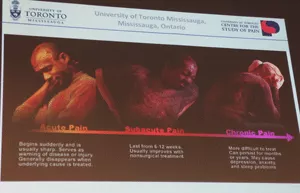
Social structures, empathy, stress and pain are all in a day’s work for some faculty members in the Department of Psychology at U of T Mississauga.
These topics were just a slice of the exceptional research showcase presented by Professors Melissa Holmes, Tina Malti and Loren Martin to staff, faculty and students at this year’s Lab Liaisons, which is an annual event hosted by UTM’s Office of the Vice-Principal, Research.
“Today we continue the tradition of Lab Liaisons with the Department of Psychology, and I have no doubt that the three speakers we have lined up for this session will present engaging and enlightening talks that will instill an even greater sense of pride about working on this campus together,” said Professor Bryan Stewart, UTM’s V.P., Research in his opening remarks.
Leading the first presentation was Professor Melissa Holmes, a social neuroscientist whose lab investigates how social factors, such as social status, influence the structure and function of neural circuits in the brain.
Holmes outlined her lab’s recent discoveries including the significance of the hormone oxytocin, which promotes a degree of loyalty in mammals and elicits a sense of wanting to stay with one’s particular group. Additionally she described their findings on how living in a social group helps individuals manage stress better, and also their line of inquiry into neurogenesis, which relates to the process of new brain cells developing, and how various changes occur in the brain over time because of this growth.

“We are trying to understand in my laboratory, and in many other laboratories around the world, what are the causes of these problem behaviours in the environment, and in the biological makeup of kids,” says Malti. “How can we prevent it as early as possible, and what can we do to promote prosocial orientations in our children, and help them to become empathic and caring?”
Malti discussed the setup of her lab spaces on the Mississauga campus, their methods of recruitment, they have an impressive database of over 30,000 participant families who have contributed to their research findings over the past 25 years in the developmental psychology laboratories at UTM, and she provided examples of the kinds of questions they ask children to determine their reactions and emotions to various situations. In the interventions they have developed, Malti says they focus on a “strengths-based approach,” which draws on children’s strengths and positive attitudes, as opposed to strategies that have risk and negative aspects of behaviour at its core.
Lastly, Professor Loren Martin, a behavioural neuroscientist who recently joined the department in January 2015, presented on his neurobiological, chronic pain research, and made the case for the importance of this type of investigation, partly because there is such a high number of North Americans, approximately 30-40%, who report that they suffer from chronic pain, but also because of the financial burden it places on the healthcare system.
“If you compare chronic pain to other prominent diseases that researchers like to study it costs our economy, our society, our employers far more than almost all the other diseases combined,” says Martin, who characterized chronic pain as persistent pain that lasts longer than six months.
Martin detailed the neurobiology of pain research that he conducts in his lab and how psychological and social variables, such as empathy, familiarity, housing, etc., modify pain perception. He also looks at a protein called epiregulin, which gets released in the spinal cord and its relation to pain receptors, and also empathy and “contagious-pain hypersensitivity” where pain is amplified when sufferers are familiar with one another. Martin’s lab also found that stress blocks empathy.
To conclude the event, Stewart expressed his gratitude to the many attendees and presenters who came out for the session that was held on July 8.
“I wanted to thank everyone for coming out for Lab Liaisons this year, and I would especially like to thank Professors Holmes, Malti and Martin for their excellent presentations,” concluded Prof. Stewart. “We are also grateful to the facilities and engineering staff who contribute to our research, and maintain the smooth functioning of labs and research spaces on the UTM campus.”
By Carla DeMarco
